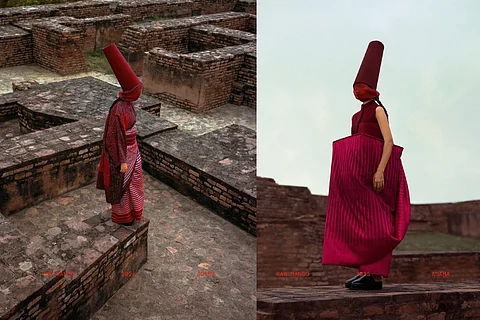
- HOMEGROWN WORLD
- #HGCREATORS
- #HGEXPLORE
- #HGVOICES
- #HGSHOP
- CAREERS
- ABOUT US
- CONTACT US

Fashion as an artistic medium is about more than just aesthetics. Narratives are woven through every garment. The fabric chosen, its silhouette, how it’s sewn together and embellished all amalgamate in a final product that expresses the designer’s inner self, and later, the wearer’s, too. This is as true of a poorly made fast-fashion t-shirt as it is of the world’s most luxurious and intricately designed gowns. No matter how simply made, and whether consciously or not, every item of clothing is imbued with meaning.
Raw Mango is a Homegrown favourite because it understands the importance of every stitch and thread in telling the stories of its pieces. The label’s latest collection, Agama, is a tribute to ancient techniques and textile innovations, interlacing craft traditions with a modern flair. Every aspect of the garments in the Agama collection is intentional, using its design elements to tell the story of a fictional nomadic tribe. India’s long history of pilgrimage and nomadic communities created a rich cultural exchange, allowing for overlaps in craft traditions across the country. Agama pays homage to this movement and shared artistry.
In Sanskrit, “Agama” translates to “That which has been passed down from tradition.” This transference of knowledge is at the heart of Raw Mango’s new collection. However, rather than confining itself to one region’s history and practices, Agama imagines a nomadic tribe moving from one place to another, picking up textiles and techniques as they go. Designer Sanjay Garg told Elle Magazine that the collection draws from Central Asian silhouettes and Bengali and Deccan textiles. The collection’s nomadic concept also extends beyond its varied style inspirations; each piece is versatile, designed with migration between different climates and environments in mind.
Agama’s use of ancient knowledge envisions new stories while also honouring cultural histories. The use of Ikat Mashru, in particular, is a central tenet of this collection. Since 2015, Raw Mango has contributed to the revival of Mashru, a technique that blends cotton and silk fibres. With each new collection, Raw Mango seems to spotlight a different iteration of Mashru, this time combining it with the Ikat dyeing technique as done in the Deccan. This technique was also used by Suraiya Hasan Bose, an iconic textile conservator and inspiration to Garg. He told Elle Magazine that, before her passing, she had told Garg to continue Ikat Mashru’s production. Agama, then, is a continuation of collective and personal histories.
Storytelling is more than just words on a page. In Raw Mango’s case, India’s ancient stories are steeped in every decision that makes Agama what it is. Past, present, and future are seamlessly woven together as one and shine like a Mashru cotton-silk blend.
If you enjoyed reading this, here’s more from Homegrown:
A Moveable Feast: Iftar In Kolkata's Zakaria Street Is An Experience Unlike Any Other
Countrymade's New Collection Channels Handcrafted Narratives Of War, Memory, & Resilience
A Gorkey Patwal & Zuri Camille De Souza Short Unpacks The Essence Of Love & Parenthood
